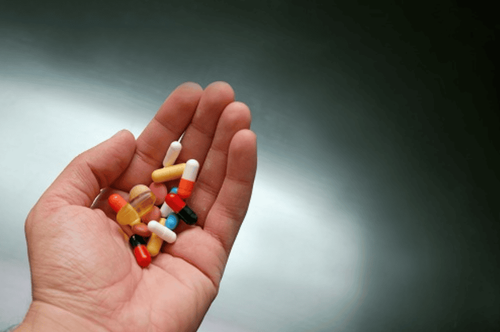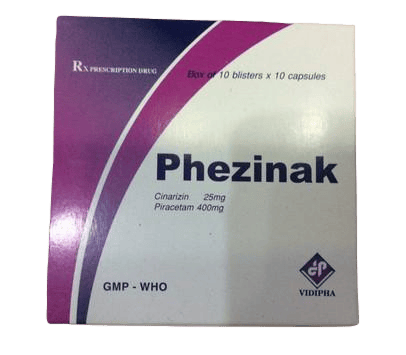This is an automatically translated article.
Stacetam medicine has the main active ingredient Piracetam and other excipients in a sufficient amount. This is an oral drug that is used to treat diseases caused by brain damage, psychosis, ischemia, headache, delirium, brain disorders and disorders of consciousness.
1. What is Stacetam?
What is Stacetam? Stacetam has the main active ingredient Piracetam with the strength of 800mg, Cinnarizin with the content of 25mg and other excipients with a sufficient amount of 1 tablet. This is a psychotropic drug used to treat diseases caused by brain damage, ischemia,...
Stacetam is made in the form of film-coated tablets, suitable for direct oral use. Packing is box of 10 blisters, each blister contains 10 tablets.
1.1. Pharmacodynamics of the active ingredient Piracetam Active ingredient Piracetam is a manic drug that improves the metabolism of nerve cells.
1.2. Pharmacokinetics of the active ingredient Piracetam Absorption: After oral administration, it is rapidly and almost completely absorbed from the gastrointestinal tract. The bioavailability of the active substance is approximately 100%. The absorption of this drug does not change with long-term treatment. Distribution: The mean volume of distribution is about 0.6l/kg. Active ingredient Piracetam penetrates all tissues in the body and can cross the blood-brain barrier, placenta and membranes used in renal dialysis. Active ingredient Piracetam is not bound to plasma proteins. Elimination ability: Active ingredient Piracetam is excreted by the kidneys in an intact form, the renal clearance of Piracetam for normal subjects is 86ml/min. 30 hours after oral administration, more than 95% of the drug is excreted in the urine. In patients with renal failure, the half-life is increased. 1.3. The action of the active ingredient Piracetam Active ingredient Piracetam is a cyclic derivative of gamma aminobutyric acid, GABA, which is considered a stimulant with the effect of improving the metabolism of nerve cells. However, up to now, the specific effect as well as its mechanism of action has not been determined. Active ingredient Piracetam acts on a number of neurotransmitters such as acetylcholine, noradrenalin, dopamine... The drug can change nerve conduction and the effect of improving the metabolic environment, creating conditions for cells nerve cells work well. Experimentally, the active ingredient Piracetam has a protective effect against ischemic-induced metabolic disorders by increasing the brain's resistance to hypoxia. The active ingredient Piracetam increases glucose mobilization and utilization independent of oxygen supply, facilitates the pentose pathway and maintains energy synthesis in the brain. Active ingredient Piracetam also has the effect of increasing the release of dopamine, which has a good effect on memory formation. Active ingredient Piracetam has no effect of causing sleep, sedation, resuscitation, pain relief. Piracetam reduces platelet aggregation and in some cases of abnormally stiff red blood cells it can work to restore erythrocyte deformability and capillary passage. The drug is also effective in anticonvulsants.
2. What is Stacetam used to treat?
Stacetam drugs are used in the treatment of the following pathologies:
Treatment of diseases caused by brain damage, symptoms of brain surgery and brain injury, psychosis, stroke, ischemia, hemiplegia . Treatment of diseases caused by disorders of peripheral and central brain: dizziness, dizziness, headache, severe delirium. Treatment of diseases caused by brain disorders, namely coma, signs and symptoms of senility, disturbances of consciousness. Treatment of cerebrovascular accidents, carbon monoxide poisoning and accompanying sequelae. Treatment of cognitive impairment and chronic sensory neuropathy in the elderly. Treatment of learning difficulties in children, people with chronic alcoholism, myoclonic tremor. Prophylactic treatment of motion sickness.
3. Usage and dosage of Stacetam
Stacetam 800 mg is prepared in the form of film-coated tablets and is administered orally, with the usual dose:
The usual therapeutic dose is 30-160 mg/kg/day, divided equally into 2 or 3 to 4 times. times/day. Long-term treatment of psychosomatic syndromes in the elderly: 1.2 - 2.4 g/day. Therapeutic dose may be as high as 4.8 g/day/first weeks. Dosage for treatment of alcoholism: 12g/day/first period of alcohol withdrawal. The maintenance dose is 2.4g/day. Dosage for cognitive impairment after brain injury: Initial dose: 9-12g/day, maintenance dose is 2.4g/day, taken for at least 3 weeks. Dosage for treatment of sickle cell anemia: 160 mg/kg/day, divided equally into 4 times. Dosage for treatment of myoclonus: 7.2 g/day, divided into 2-3 times. Depending on response every 3-4 days, increase by 4.8 g/day to a maximum dose of 20 g/day. Prevention of risk of motion sickness: For adults: take 1 tablet, 2 hours before traveling by train, then take another tablet, every 8 hours during the journey if needed. For children, use 1/2 of the usual treatment dose as adults. The dosage as shown above is the common dosage and is for reference only. You should consult your doctor or specialist pharmacist before deciding to use Stacetam.
4. In case of drug overdose
In case of overdose: You should use Stacetam at the correct dose according to the instructions to achieve the best treatment effect. Stacetam overdose may have specific signs and symptoms such as vomiting, drowsiness, coma, tremor, hypotonia. Currently there is no specific antidote. Within 1 hour after drinking, the stomach should be washed or activated charcoal can be used if it is appropriate. In case of missed dose: Take a new dose of Stacetam as soon as you remember, do not increase the dose to make up for it.
5. Undesirable effects of Stacetam
During the use of Stacetam, users may experience some undesirable effects, specifically as follows:
Common undesirable effects with ADR > 1/100:
Whole body: Increased feeling of fatigue fatigue; Central Nervous System: Somnolence; Gastrointestinal: Digestive disorders. Uncommon side effects, 1/1000< ADR< 1/100:
Whole body: Dizziness, dizziness; Nervous: Tremor, sexual arousal accompanied by headache; Digestion: Dry mouth, rapid weight gain; Other: Increased sweating, allergic reactions. Rare adverse effects, ADR < 1/1000
Central nervous system: Extrapyramidal symptoms in the elderly or long-term treatment Cardiovascular: Decrease in blood pressure when using the drug in high doses high. If you experience the above symptoms or any unusual manifestations, you should notify your treating doctor for advice on reducing the dose or for the most appropriate instructions.
6. Stacetam drug interactions
Avoid using Stacetam with drugs that stimulate the central nervous system, thyroid hormone.
You should consult a professional before combining Stacetam with any other medicine.
7. Some notes when using Stacetam
7.1. Contraindications of the drug Stacetam People with hypersensitivity or sensitivity to the active ingredient Piracetam, Cinnarizine or one of the ingredients of the drug. Patients with severe renal impairment with creatinine clearance less than 20 ml/min Person with Huntington's disease. People with liver failure. For women who are pregnant and those who are breastfeeding. 7.3. Notes and cautions when using Stacetam In the composition of the drug Stacetam contains Cinnarizine. This is an active ingredient that can cause epigastric pain. You should take the medicine after a meal as it can reduce stomach irritation. Long-term use of Cinnarizine must be avoided in the elderly. The reason is that the drug can cause an increase or appearance of extrapyramidal symptoms, sometimes associated with feelings of depression during prolonged treatment. Since the main active ingredient Piracetam is excreted by the kidneys, the increased half-life is directly related to the degree of renal impairment and creatinine clearance. Stacetam should be used with caution in patients with renal impairment. The treating doctor will assign monitoring of kidney function through blood test indicators for these patients and elderly patients. Use caution when using Stacetam for people with a history of liver or kidney failure, epilepsy, the elderly 7.4. Use with pregnant or lactating women Stacetam is contraindicated in pregnant or lactating women. Stacetam can cross the placenta and is excreted in human milk. This medicine should not be used by pregnant and lactating women.
7.5. Using the drug with drivers and operating machines Undesirable effect is somnolence may occur, especially at the beginning of treatment. Therefore, caution should be exercised while engaging in activities such as driving or operating machinery. Above is all information about Stacetam drug, patients need to carefully read the instructions for use, consult a doctor / pharmacist before use. Absolutely do not arbitrarily buy Stacetam drugs to treat diseases at home, because there may be unwanted side effects to health.
Follow Vinmec International General Hospital website to get more health, nutrition and beauty information to protect the health of yourself and your loved ones in your family.
Please dial HOTLINE for more information or register for an appointment HERE. Download MyVinmec app to make appointments faster and to manage your bookings easily.













